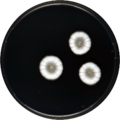Biology:Penicillium inflatum
From HandWiki
Short description: Species of fungus
| Penicillium inflatum | |
|---|---|
| Scientific classification | |
| Domain: | Eukaryota |
| Kingdom: | Fungi |
| Division: | Ascomycota |
| Class: | Eurotiomycetes |
| Order: | Eurotiales |
| Family: | Aspergillaceae |
| Genus: | Penicillium |
| Species: | P. inflatum
|
| Binomial name | |
| Penicillium inflatum Stolk & Malla (1971)[1]
| |
| Type strain | |
| ATCC 48994, CBS 682.70, CCFC007491, CCFC007492, DAOM 213168, FRR 1549, IMI 191498, MUCL 38965, NRRL 5179[2] | |
| Synonyms | |
|
Aspergillus inflatus | |
Penicillium inflatum (also named Aspergillus inflatum) is an anamorph species of the genus of Penicillium which produces sterigmatocystin.[3][4][5][6] It is from the Cremei section.[7]
Growth and morphology
A. inflatus has been cultivated on both Czapek yeast extract agar (CYA) plates and Malt Extract Agar Oxoid® (MEAOX) plates. The growth morphology of the colonies can be seen in the pictures below.
Further reading
- Geoffrey Michael Gadd (2006). Fungi in Biogeochemical Cycles. Cambridge University Press. ISBN 0521845793.
- Rank, C; Nielsen, K. F.; Larsen, T. O.; Varga, J; Samson, R. A.; Frisvad, J. C. (2011). "Distribution of sterigmatocystin in filamentous fungi". Fungal Biology 115 (4–5): 406–20. doi:10.1016/j.funbio.2011.02.013. PMID 21530923.
References
- ↑ Stolk A.C., Malla D.S. (1971). "Penicillium inflatum sp.nov". Persoonia 6 (2): 197–200.
- ↑ Straininfo of Penicillium inflatum
- ↑ ATCC
- ↑ UniProt
- ↑ Robert A. Samson, J I Pitt (2000). Integration of Modern Taxonomic Methods For Penicillium and Aspergillus Classification. CRC Press. ISBN 9058231593.
- ↑ Rank, C; Nielsen, K. F.; Larsen, T. O.; Varga, J; Samson, R. A.; Frisvad, J. C. (2011). "Distribution of sterigmatocystin in filamentous fungi". Fungal Biology 115 (4–5): 406–20. doi:10.1016/j.funbio.2011.02.013. PMID 21530923.
- ↑ Samson, R.A.; Visagie, C.M.; Houbraken, J.; Hong, B.-S.; Hubka, V.; Klaassen, C.H.W.; Perrone, G.; Seifert, K.A. et al. (2014). "Phylogeny, identification and nomenclature of the genus Aspergillus". Studies in Mycology 78: 141–173. doi:10.1016/j.simyco.2014.07.004. PMID 25492982.
Wikidata ☰ Q10622955 entry
 |



